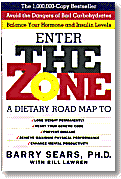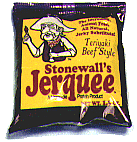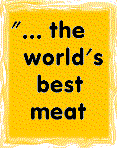 So... "Fine," you say. How do I get started if I
want to follow the Zon diet?
So... "Fine," you say. How do I get started if I
want to follow the Zon diet?
 The answer, according to Sears,
lies in getting
"macronutrient conscious." You have to be consciously aware, within
limits, of the composition of the foods you digest. Foods are
drugs, and their effects can be no less profound than the substances
you purchase from your pharmacist. The answer, according to Sears,
lies in getting
"macronutrient conscious." You have to be consciously aware, within
limits, of the composition of the foods you digest. Foods are
drugs, and their effects can be no less profound than the substances
you purchase from your pharmacist.
 A suitable starting point is
purchasing Dr. Sears' original work, Enter
The Zone. You really should understand all the benefits associated
with living in The Zone, as Sears lays out. (This article is
little more than a summary of Sears' work). If you do not understand and
have internalized the extent of the benefits, you are less likely
to make life-changing alterations in your diet. A suitable starting point is
purchasing Dr. Sears' original work, Enter
The Zone. You really should understand all the benefits associated
with living in The Zone, as Sears lays out. (This article is
little more than a summary of Sears' work). If you do not understand and
have internalized the extent of the benefits, you are less likely
to make life-changing alterations in your diet.
 Secondly, we recommend
that you purchase Dr. Sear's book, Zone Perfect Meals in
Minutes. Although we strongly disagree with Dr. Sears
emphasis on meat and other animal products to up the protein
levels of Zone meals, we see a benefit on using his work as
"dietary templates": after all, you can substitute most of his
meats with Heartline, and supplement meals
with our dried jerky snacks and still
get the full benefits of living "in the Zone," without relying on
animal proteins. (For those of you who are not familiar with our
work at Lumen Foods, our seminal book helps
explain, using over 300 scientific studies and research sources,
the many benefits of a vegetarian lifestyle.) Secondly, we recommend
that you purchase Dr. Sear's book, Zone Perfect Meals in
Minutes. Although we strongly disagree with Dr. Sears
emphasis on meat and other animal products to up the protein
levels of Zone meals, we see a benefit on using his work as
"dietary templates": after all, you can substitute most of his
meats with Heartline, and supplement meals
with our dried jerky snacks and still
get the full benefits of living "in the Zone," without relying on
animal proteins. (For those of you who are not familiar with our
work at Lumen Foods, our seminal book helps
explain, using over 300 scientific studies and research sources,
the many benefits of a vegetarian lifestyle.)
 Even before a more thorough
study of Dr. Sear's work, however, you would be closer to following
the Zone Diet by following some of these simple suggestions: Even before a more thorough
study of Dr. Sear's work, however, you would be closer to following
the Zone Diet by following some of these simple suggestions:
- Watch Between-Meal Sweets --
We mention this first
because it is so very common. By themselves, candies and similar
sweets jack up the glycemic index in short order without the presence of
proteins to "balance out the glucagon-to-insulin" axis. You
end up flooding the bloodstream with insulin. You are inadvertently
telling your body, "Store more fat now!"
- Be Conscious of Each Meal -- It isn't enough to live through
a day where you roughly observed the magic 40/30/30 macronutrient ratios.
Each meal is an opportunity to provide the body with optimal nutrient
conditions and maximize the production of those powerful hormones,
eicosanoids (which we can't elaborate on here -- even Dr. Sears's
"short course" is eight pages long). Likewise, each meal is an
opportunity to send the body into imbalance. It should also be
pointed out that this not a black and white situation: it is better
to be closer to a Zone diet than to ignore what you eat. So remember
that the Zone diet, like everything else in life, resides in an area
with many shades of gray. Just get as close as you can. The closer
you are, the more healthful benefits you'll experience.
- Importance of Antioxidants & Co-Factors -- Certain
micronutrients are adjunctive to successful eicosanoid modulation.
Supportive antioxidants include Vitamins E and C and beta carotene.
Supportive co-factors include Vitamins B3, B6; zinc and magnesium.
- Advise on Smoking & Alcohol -- Here is yet another reason
to avoid smoking: it generates enormous free radicals which
delete the body's reserves of antioxidants. This, in turn, exposes
the fatty acids that act as eicosanoid building blocks to free-radical
destruction. As for alcohol, if you must, just observe moderation.
A glass of
wine a day can actually support eicosanoid production (remember
the "French paradox"? Our European cousins who eat a high-fat
diet, don't exercise, imbibe the vino, and suffer low rates of
heart disease? You get the picture.)
- Lean On Natural Foods That Bring You Close to the
Magic Ratio -- All else being equal, chose beans over grains,
fresh fruit over its juiced equivalent, high protein beverages
over sugery sodas... a bowl of Heartline Beef Fillet
and Navy beans, still hot from the crockpot, over that tempting plate of
high-starch pasta!
|
Using Lumen Foods'
Animal Replacements
To Stay in The Zone

 Macronutrient
Macronutrient |
G./Serv. |
Caloric % |
 Fat
Fat |
6.0 |
39.13% |
 Carbohydrate
Carbohydrate |
6.0 |
17.39% |
 Protein
Protein |
15.0 |
43.48% |
The nice thing about a high protein snack is that it allows
you to balance your diet with something that would otherwise
be abusive: a high-carb sweet or a small serving of pasta.
A bag of Stonewall's Jerquee is heavy on protein,
and moderate in fat and carbs. Add 14 grams of carbs
with a smidgeon of fat (0.5... could even be candy)
to a single bag of Stonewall's and you get
fat / carb / protein ratios of 29.47 / 40.30 / 30.23.
Congratulations: you're in the kill zone.

 Macronutrient
Macronutrient |
G./Serv. |
Caloric % |
 Fat
Fat |
3.0 |
32.53% |
 Carbohydrate
Carbohydrate |
4.0 |
19.28% |
 Protein
Protein |
10.0 |
48.19% |
The serving size is small: one ounce of Heartline
Meatless Meats,
which, when
cooked, yields about 2 ounces (it doesn't have as high a
reconstitition ratio as TVP because it comes to you
re-cooked in the "intermediate moisture" or IM mode, as
food techs call it -- that is, you can eat it right out
of the bag.) Again, if you added more carbs (9 grams)
and an additional gram of fat (i.e. mashed potato with
a tiny bit of olive oil as an example), you have a fat / carb / protein
ratio that's favorable: 28.13 / 40.63 / 31.25. Good
eicosanoids here we come!

 Macronutrient
Macronutrient |
G./Serv. |
Caloric % |
 Fat
Fat |
0.0 |
00.00% |
 Carbohydrate
Carbohydrate |
9.0 |
37.50% |
 Protein
Protein |
120.0 |
62.50% |
The great thing about our Heaven on Earth Fat-Free
Milk Replacer is that it can a single glass can
take a meal that's a little higher in carbs and lower
in protein than it ought to be and bring it back to
the Zone. It does this without any of the 28
allergenic compounds found in real milk, or the health
risks associated with the X.O. enzyme
created as a result of homogenization.
|

 So... "Fine," you say. How do I get started if I
want to follow the Zon diet?
So... "Fine," you say. How do I get started if I
want to follow the Zon diet? 

